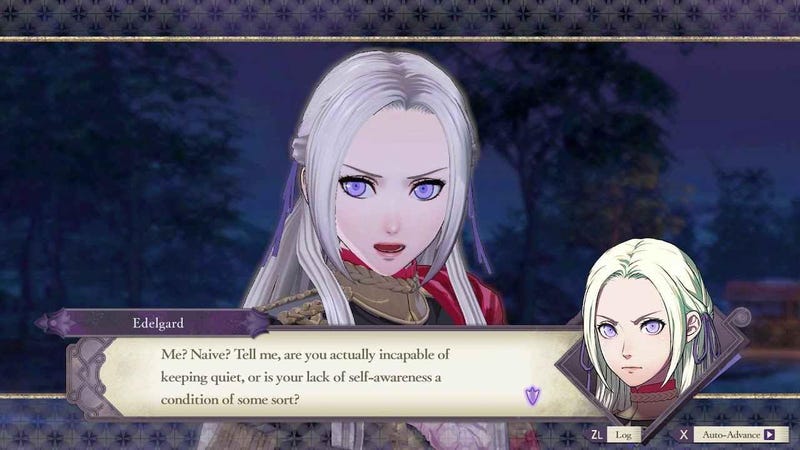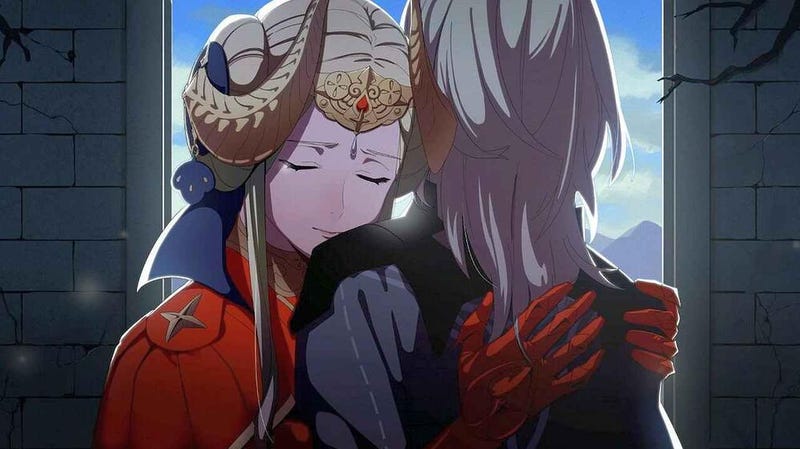Amongst an impressive library of games like Breath of the Wild, Super Mario Odyssey, and Metroid Dread, 2019’s Fire Emblem: Three Houses will still go down in my books as the best Nintendo Switch game ever made. It’s a grand fantasy story and an excellent tactical RPG that feels unmatched, even within the franchise to which it belongs. Beyond good gameplay and a fascinating world, what makes Three Houses a modern masterpiece is its cast of characters, each of whom is so phenomenally fleshed out that every single one is likely to be somebody’s favorite. But in recognition of the game’s fifth anniversary, it’s time I declared that one character stands above all the rest: Edelgard von Hresvelg, Fire Emblem: Three Houses’ greatest triumph.
As former Kotaku writer Gita Jackson put it in their review five years ago, “Fire Emblem: Three Houses is a game for interesting times.” Those interesting times call for interesting people to inhabit them, all of whom are shaped by the realities in which they live—specifically the impending war over their heads. The “three houses” of the title refer to groups within the game’s central setting of the Garreg Mach Monastery’s Officer’s Academy, one of which you choose to lead at the start of the game. There are the Blue Lions and the Golden Deer, but I am most concerned with the Black Eagles and its seemingly cold-hearted leader, Edelgard.
Each house leader is the presumptive heir to a given political body within the world of Three Houses. They play as schoolmates and tentative friends, but all exist under the looming shadow that they will likely be enemies when (not if) that impending war does finally begin. Edelgard is the only one of the three who seems to have put any thought into this reality in the game’s first section, which is set during their time at school while a mysterious antagonist known as the Flame Emperor terrorizes the monastery. This can make her an off-putting figure, someone who comes off as calculating and uncaring. As the only female leader, one who, if taken at face-value, could be seen simply as a shallow, bossy woman, it is perhaps unsurprising that the white-haired ruler to be rubbed some people the wrong way. Cut to the game’s big reveal that Edelgard is, in fact, the Flame Emperor, here to overthrow the way of life you and the rest of the game’s cast have been training to preserve. She’s a dangerous, despotic revolutionary that you spend the game’s second section working to defeat. At least, that’s how it goes in all but one timeline.

If, at the start of the game, you choose to act as steward for the Black Eagles, you have the chance to build a relationship with Edelgard that eventually leads to her confessing her true identity and mission before asking you to join her. Doing so begins the Crimson Flower route. Given the cold and shallow demeanor Edelgard presents at the game’s start, it isn’t necessarily something people will stumble on themselves. Even for those who do choose her house, it requires continued persistence to reach the point where she trusts you enough to reveal her secrets. In other routes, the only identity she earns is that of a horrible antagonist that must be stopped at all cost. In Crimson Flower and the Black Eagles route through the game’s first section, she gets to be human.
Referring to the reveal of Edelgard’s identity as the Flame Emperor as a twist feels inaccurate. If you join the Black Eagles and spend time with her it feels almost obvious, as it’s the natural step to take given how Edelgard sees the world of Three Houses. In the first half of the game, you’re presented with story beat after story beat that openly show the medieval fantasy world to be a place bereft with horrible class inequality and ingrained ways of life held up by the church, the very institution you serve. Much of this inequality comes down to Crests, special marks that, over time, have been used to decide nobility. These Crests are hereditary and lead to women born with Crests often being seen as vessels to give birth to men who can pass on the special powers, an issue seen explicitly with Ingrid’s story. These issues, and more personal traumas like the massacre of her entire family, have turned Edelgard into the cold woman we meet at the beginning of the game. But if you accompany her throughout the first half, we see these horrific realities of the world up close. If you pay attention to the world, then Edelgard’s mission isn’t much of a twist. The reasons behind what Xeecee accurately named her “call to arms” in a 2019 article for Vice are all laid bare for you to see.
As shown in her school time, Edelgard is the only future leader in the world of Three Houses who is concerned with changing the systems in place in order to benefit the people. The other leaders, Dimitri and Claude, are concerned with retaining their—and their kingdoms’— place in the status quo. They may talk about caring about their people, but it’s in an us vs them mindset that fears losing a place in the upper echelons of a world governed by the church. Through Edelgard, Three Houses gives you the rare chance to do something truly revolutionary as a protagonist. It invites you to actually leave the world of the game a better place than when you found it.

This isn’t a simple thing for Edelgard, either. In many ways she has given up her identity and life in order to pursue change for everyone. Part of the beauty of the Crimson Flower path and leading the Black Eagles during their time at the Officer’s Academy is getting to breathe some humanity back into her after the horrific life she has lived. Again, the downside is that you only see this side of her if you choose to lead the Black Eagles and then follow Edelgard in her revolution. It locks so much of the best writing and character work in the entire game behind so many choices, but in some ways it’s better for it, as it requires you to truly seek it out through your love of Edelgard.
Edelgard remains a widely hated character in Three Houses. She is easily painted as an irredeemable villain who causes mass murder, all for the sake of her own goals. Of course, she isn’t perfect, but the game goes to great lengths to show the cost of revolution is high but necessary. Edelgard is sacrificing her own humanity, and it eats away at her. The revolution is not something she takes lightly, and she even confides in you that she worries the cost will be too high in the end. But holding the systems of oppression in the world of Three Houses accountable is something that must be done, and it will mean change for the better. It shouldn’t be overlooked that it is so easy for a particular subset of players to utterly demonize the female lead (if we consider the house heads as leads, which I think is fair to do). At the end of the day, every character in every route is responsible for a long list of deaths and war crimes, but only one of the house leaders has a distinct moral drive behind every action they take.
For queer players, her route takes on even more meaning if you choose to be the female protagonist of the game. Edelgard is romanceable regardless of gender and in a story of revolution, in which she is fighting to break down oppressive institutions, reading her as queer just clicks. Building a relationship with Edelgard is the central pillar of understanding the moral imperative to fight alongside her. It also, as I previously mentioned, helps to breathe humanity into her in a world that has worked so hard to tear it out. It sounds cliche, but by giving her love and romancing her, you can make the story of revolution all the more poignant. She is not just fighting for a better world for those around her, but so she can be the truest version of herself without judgment.

To Edelgard’s detriment, Crimson Flower is the shortest route in Three Houses. Yet it packs so much remarkable storytelling into a smaller package than its counterparts. It robs her of a true catharsis, relegating the fruits of her labors to epilogue text. Furthermore, each route that follows a different house leader ends with corruption being rooted out from the world of Three Houses, so in the end, many may wonder why Edelgard’s methods were even necessary or justified. But again, even if the world changes regardless of who you choose, Edelgard is the only ruler who sets out with that change in mind as her singular goal. Her devotion to that mission is also what enlightened the other leaders around her, persuading them to eventually work for some level of change, even in the routes in which she is killed for her crimes.
Three Houses is a game you’re encouraged to play through many times in order to see all the different routes and permutations, but at the end of the day, if someone asked me what single route they should play, I would answer Crimson Flower. Edelgard is not right about everything, she is not perfect. She is, however, the most compelling and well-written character in Fire Emblem: Three Houses. She will never deserve the hate she gets. That was true in 2019 and it is true now, five years later. Edelgard Von Hresvelg, you will always be famous.
.

Leave a Reply